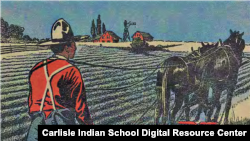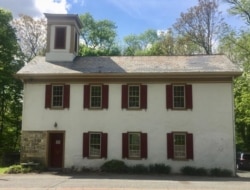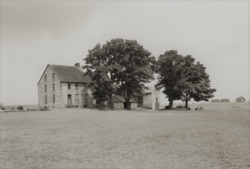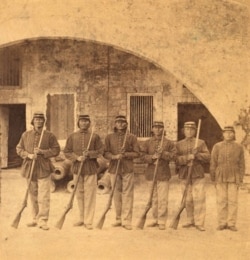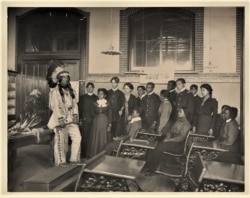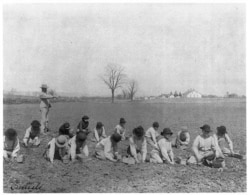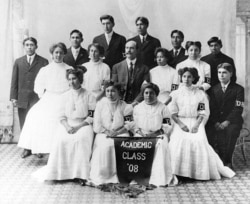If it weren't for the COVID-19 pandemic, Gina Sampaio would never have known about the federal government's Indian boarding school system, which removed children from family and community and placed them in schools to become "assimilated."
A writer and performer from New Jersey, Sampaio in 2019 took the job of curator of the tiny Lebanon Township Museum, housed in an early 1800s schoolhouse in New Hampton, New Jersey. She'd only been at her new job for a year when the coronavirus pandemic forced her to close the museum's doors to the public for nearly a year and a half.
It was the perfect opportunity to start poking into some of the thousands of records and artifacts in the museum's collection.
"I came across these notes, handwritten on yellow legal paper," she said. "I'd seen them a million times before. But for some reason, this time I decided to take a closer look."
She came across references to "Indian boys" working and going to school in New Hampton.
"The note that cracked it all open for me talked about Indian boys at Carlisle School, which I'd never heard of before," she said.
A Google search landed her at the Carlisle Indian School Digital Resource Center, a Dickinson College comprehensive database of Carlisle Indian School photographs and documents that have been housed for decades at the U.S. National Archives.
There, she learned that between 1892 and 1918, dozens of Carlisle students, some as young as 12, had been sent to live and work on white-owned New Hampton farms as part of an "Outing Program" from the school in the neighboring state of Pennsylvania.
"And I'm seeing all this and thinking to myself, why at my age have I never even heard about Indian residential schools or that students came here to work?" she said. "And I'm still really angry about it. Why weren't we taught any of this in school?"
'Supreme Americanizer'
While supervising Native American war prisoners in St. Augustine, Florida in the 1800s, former U.S. Cavalry officer Richard Henry Pratt encouraged inmates to have regular interactions with locals and tourists.
In his memoir "Battlefield to Classroom," Pratt spoke of wanting to better race relations: "I conceived it my highest duty to correct the unwarranted prejudice promoted among our people against the Indians through race hatred and the false history which tells our side and not theirs."
He also wrote that it was equally important to "remove from the Indian's mind his false notion that the greedy and vicious among our frontier outlaws fairly represented the white race."
In April 1878, he escorted a group of about two dozen of the now-freed prisoners to the Hampton Normal and Agricultural Institute in Virginia, a school established to educate former slaves. That's when he began pitching the idea of placing Native students in non-Native homes "to gain practical knowledge for managing their own farms."
After Pratt opened the first federal Industrial Indian School in Carlisle, he formalized the outing system, which he dubbed "the supreme Americanizer."
Pratt planned to place them on farms or in homes where they could work and earn money over the summer and, in some cases, throughout the school year, attending public schools in their patrons' localities.
"This brings the Indian youth directly in contact with good, wholesome, civilized life, and they absorb it rapidly, and it absorbs them, and they become a part of it," he boasted in an 1895 letter to the Commissioner of Indian Affairs in Washington.
In his memoir, Pratt admitted that the first outing was a disaster: half of the 23 students placed on local farms ran away or were sent back by the host families. So, Pratt arranged for them to be sent as far as New Jersey and Maryland.
The program grew over the years. In 1885 alone, Pratt placed 250 students on outings, nearly half of them year-round, on farms and in households. In time, he began contracting out students to plants and factories.
Students were allowed to keep a portion of their earnings to spend on necessities; the school kept the remainder until after they graduated. Pratt withheld the earnings of students who ran away. Records contain several letters from students complaining they had never received their money at all.
Seasonal labor
The government and public were impressed by Pratt's model and just three months after Carlisle opened, a second off-reservation boarding school opened in Forest Grove, Oregon, which later moved to the town of Chemawa.
By 1908, 27 such schools dotted the West, where new technologies had transformed farming into big business. Schools like the Teller Indian School in Grand Junction, Colorado, began sending students out to work on large farms and orchards.
"Whether this became a supervised educational program operated by the school or a device to cover the use of Indian students as seasonal labor … is difficult to determine from the official reports," retired Colorado Mesa University historian Don MacKendrick wrote in 1993.
K. Tsianina Lomawaima (unenrolled Muscogee), a retired professor of Native American studies and member of the American Academy of Arts & Sciences and the National Academy of Education, has written extensively on Indian boarding schools.
"Teller would send out work gangs of young men to labor on large sugar beet farms, for example," she said. "They wouldn't live in farmers' homes. They'd be put up in bunkhouses – or worse."
Teller students earned thousands of dollars a year, but an inspection in 1890 revealed that the school's superintendent was funneling money out of the school for personal use. The money – and account books – had disappeared.
Girls at urban boarding schools, such as the Sherman Institute in California or the Phoenix School in New Mexico, were sent out as domestics.
In her book, "The Students of Sherman Indian School," historian Diana Meyers Bahr cites the case of a student who reported leaving an outing job because the man of the house would peek at her through her bedroom keyhole.
Carlisle scandal
In 1914, 10 years after Pratt was forced to resign from Carlisle, the outing system had degenerated. Students and teachers had made allegations of financial mismanagement and neglect against the school's third superintendent, Moses Friedman. The Indian Bureau sent an inspector to Carlisle, and his findings resulted in a joint congressional hearing at the school.
"The idea of the outing, as originated by General [sic] Prat...was to place them not as servants but sort of helpers, getting wages from what they did," girls' outing manager Rosa B. La Flesche told lawmakers. "That principle has been lost."
She stated that students no longer received vocational training at the school and that Friedman had pressured her to "send out" as many students as possible so that "the income from that source would be higher."
"The farmers … get the boys and girls for the work they can get out of them," she said.
Students were paid but told lawmakers they no longer held bank books or interest statements and had no way of knowing how much money they had saved.
Friedman was forced to resign, and the school would close forever in 1918.
'Invisible sons'
Through her research into the Carlisle Digital Research files, Lebanon Township Museum curator Sampaio learned that at least 34 Carlisle students lived, labored and studied in New Hampton. Charles Paisano, a student from the Laguna Pueblo in New Mexico, would die there at the age of 20.
Sampaio and associate Robbie-Lynn Mwangi organized an online presentation, "The Invisible Sons Project," to help educate the public about the Indian boarding school system and the children who were part of it.
"Then the New Jersey Historical Commission announced this year's conference November 12th and 13th would be about indigenous history in the state, so we'll be presenting there," she said.
On "Orange Shirt Day," September 30, the day Canada acknowledges residential school students, Sampaio conducted what she hopes is the first of many classroom presentations on the Indian boarding school experience.
"I worried that I didn't make a good impression," she said. "But later, I learned that they talked about it for the rest of the day."
NOTE: In the third article in this series, VOA will explore what caused the deaths of so many boarding school students and whether a full accounting will be possible.
Editor's note: An earlier version of this story misspelled Dickinson College.




